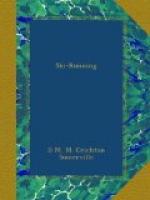In every case the essence of the Christiania is that the swing should be rapid, and that the preliminary stemming or diverging of the skis should be as slight as possible.
A turn started by pronounced stemming and completed as a Christiania should not be passed.
Continuous Turns are sometimes known as “downhill turns.” They are used to connect one tack with another, and differ from stop or uphill turns in that the turn is made away from the hill instead of up towards the hill. Candidates must not stop between two continuous turns.
Hard Snow.—For the purpose of these tests, any well-beaten down practice slope from which all traces of soft snow have disappeared may be considered as hard snow. Hard crust superficially softened by the sun cannot be considered as hard snow.
Soft Snow.—For the purpose of these tests, a deep layer of powder snow resting on hard crust, or hard crust superficially softened by the sun, but not breakable, may be considered as soft snow.
Form.—The Judges must consider the “form” of the runner, as well as his speed and steadiness. The distinguishing marks of good “form” are an easy balance without dependence on the sticks (see below), an erect position, except on steep slopes, and a narrow single spoor in soft snow.
Use of the Sticks.—Candidates should carry sticks throughout these tests, but the sticks should not be used to reduce speed nor to help out a turn. On the other hand, a candidate may be allowed a prod with a single stick at the end of a turn provided that he is carrying a stick in each hand, or in the event of the candidate using a single stick that this stick is only held in one of his hands. He must not put both his sticks together, nor hold a single stick in his two hands, during any of these tests, unless expressly directed to do so by the Judge.
THE THIRD CLASS TEST (CROSS COUNTRY).
The Third Class Test consists of three parts, which may be passed on different days, and before different Judges.
Part (a).—The ascent of 1,500 feet in not more than 1 hour 30 minutes, and the descent of the same distance within a time which shall be decided by the Judges. This time shall not be less than 7 minutes, nor more than 20 minutes, and shall not exceed 12 minutes unless sanctioned by a Second Class Judge or member of the Emergency Committee who is present and judging.
Part (b).—Four continuous Lifted Stemming turns on a slope of hard snow or hard snow covered by a shallow layer of soft snow. The angle of the slope to be between 15-20 degrees.
Part (c).—Four continuous Telemarks in soft snow on a slope of similar gradient.
INSTRUCTIONS TO JUDGES.
1. The course selected for Part (a) should include at least 200 feet of moderately difficult ground. Courses such as the Lauberhorn at Wengen, which is an unbroken descent of 1,500 feet that a good runner could take straight, should not be chosen. No part of the course should be along a road.




